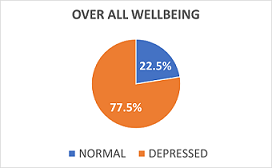Level of Well-Being among School Going Adolescents

Abstract:
The adolescence state is the progressive transition from
childhood to adulthood. They have specific needs which vary with gender, life circumstances,
and socioeconomic level. In this stage, they suffer from various forms of problems
and conflicts, which ultimately impair normal development and move to a depressive
state. This study assessed the level of well-being among school-going adolescents
in the south region of Tamilnadu; The uni-variable, descriptive-
cross-sectional research design was adopted. Through the convenient sampling technique,120
school-going adolescents responded to the adolescent’s well-being questionnaire
(11-16 years) through online Google forms. The collected data were analyzed through
the SPSS package. In the results, the majority of school-going adolescents (77%)
were depressed and there is a significant association found between gender and grade
(P= 0.05%). The nursing fraternities of community and public health nurses and stakeholders
in the community take the initiation of remedial measures to support and promote
the mental health of adolescents.
References:
[1] Quality
of life, Physiopedia. Available from
https://www.physio-pedia.com/Quality_of_Life.
[2] Ross
DA, Hinton R, Melles-Brewer M, Engel D, Zeck W, Fagan L, Herat J et al., (2020)
Adolescent Well-Being: A Definition and Conceptual Framework. J Adolesc Health
Oct;67(4):472-476. doi: 10.1016/j.jadohealth.2020.06.042.
[3] Who,
Mental health of adolescents, Nov 2021,
https://www.who.int/news-room/fact-sheets/detail/adolescent-mental-health.
[4] Cavioni
V, Grazzani I, Ornaghi V, Agliati A, Pepe A. Adolescents’ Mental Health at
School: The Mediating Role of Life Satisfaction. Front Psychol. (2021) Aug 18;
12:720628. doi: 10.3389/fpsyg.2021. 720628.
[5] Nawi,
A.M., Ismail, R., Ibrahim, F. et al. (2021) Risk and protective factors of drug
abuse among adolescents: a systematic review. BMC Public Health 21, 2088.
https://doi.org/10.1186/s12889-021-11906-2.
[6] Patton,
G., Olsson, C., Skirbekk, V. et al. (2018). Adolescence and the next
generation. Nature 554, 458–466 https://doi.org/10.1038/nature25759.
[7] Wood,
D. et al. (2018). Emerging Adulthood as a Critical Stage in the Life Course.
In: Halfon, N., Forrest, C., Lerner, R., Faustman, E. (eds) Handbook of Life
Course Health Development. Springer, Cham.
https://doi.org/10.1007/978-3-319-47143-3_7.
[8] Centers
for Disease Control and Prevention. (2020). Data and statistics on children’s
mental health. https://www.cdc.gov/childrensmentalhealth/data.htm.
[9] Mental
health disorders in adolescents. (2017) Committee Opinion No. 705. American
College of Obstetricians and Gynecologists. Obstet Gynecol;130: e32–41.
[10]
Youth in India (2022) Social statistics
division, National statistical office, Ministry of Statistics & program
implementation, Government of India.
https://mospi.gov.in/sites/default/files/publication
_reports/Youth_in_India_2022.pdf.
[11]
Hossain MM, Purohit N. (2019) Improving
child and adolescent mental health in India: Status, services, policies, and
way forward. Indian J Psychiatry. 61(4):415-419. doi:
10.4103/psychiatry.IndianJPsychiatry_217_18.
[12]
Das JK, Salam RA, Lassi ZS, Khan MN,
Mahmood W, Patel V, Bhutta ZA. (2016) Interventions for Adolescent Mental
Health: An Overview of Systematic Reviews. J Adolesc Health. Oct;59(4S):
S49-S60. doi: 10.1016/j.jadohealth.2016.06.020.
[13]
Cavioni V, Grazzani I, Ornaghi V, Agliati
A, Pepe A. (2021) Adolescents’ Mental Health at School: The Mediating Role of
Life Satisfaction. Front Psychol. 18; 12: 720628. doi:
10.3389/fpsyg.2021.720628. PMID: 34484083; PMCID: PMC8416350.
[14]
Adolescent Well-being Scale, Youth Rex-
Research and Evaluation Exchange. Available in
https://youthrex.com/wp-content/uploads/2019/10/Adolescent-Wellbeing-Scale.pdf.
[15]
Khan Y, Taghdisi MH, Nourijelyani K.
(2015) Psychological Well-Being (PWB) of School Adolescents Aged 12-18 yr, its
Correlation with General Levels of Physical Activity (PA) and Socio-Demographic
Factors in Gilgit, Pakistan. Iran J Public Health ;44(6):804-13.
[16]
Zablotsky B, Black LI, Maenner MJ, et al.
(2019) Prevalence and trends of developmental disabilities among children in
the US, 2009–2017. Pediatrics;144: e20190811.
https://doi.org/10.1542/peds.2019-0811 PMID:31558576.
[17]
Zablotsky B, Black LI, Maenner MJ, Schieve
LA, Blumberg SJ. (2015) Estimated prevalence of autism and other developmental
disabilities following questionnaire changes in the 2014 National Health
Interview Survey. National Center for Health Statistics Reports. 2015; 87:1–20.
[18]
Bhatia SK, Bhatia SC. Childhood, and
adolescent depression. Am Fam Physician. 2007 Jan 1;75(1):73- 80. PMID:
17225707.
[19]
Jha KK, Singh SK, Nirala SK, Kumar C,
Kumar P, Aggrawal N. (2017) Prevalence of Depression among School-going
Adolescents in an Urban Area of Bihar, India. Indian J Psychol
Med.;39(3):287-292. doi: 10.4103/0253-7176.207326.
[20]
Steinmayr R, Wirthwein L, Modler L and
Barry M. (2019) Development of Subjective Well-Being in Adolescence. Int. J.
Environ. Res. Public Health. 16, 3690 doi:10.3390/ijerph16193690.

